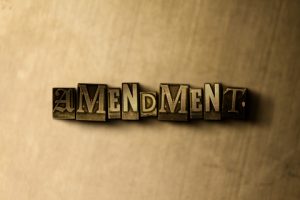 We agree with most judicial decisions, though there are a very few we think are misguided (read that as “wrong”). But, it isn’t very often at all when we’re not sure what we think. Today, we’ll present one of those, a “slip opinion” about whether a landlord could “withdraw” a notice when the lease didn’t say so – either way.
We agree with most judicial decisions, though there are a very few we think are misguided (read that as “wrong”). But, it isn’t very often at all when we’re not sure what we think. Today, we’ll present one of those, a “slip opinion” about whether a landlord could “withdraw” a notice when the lease didn’t say so – either way.
The lease included a reasonably comprehensive set of provisions designed to allow a landlord to redevelop a multi-tenanted building, one with high-end retailers (and possibly others). The redevelopment, if implemented, would take up to three years before the building could be re-tenanted. The building had to be empty during the redevelopment.
Basically, the lease gave the landlord the right to “suspend” it for up to three years. During the “suspension,” it would be as if there was no lease. When the redevelopment was completed, the lease would spring back into effect, essentially as if time had stopped while the redevelopment was taking place. [Read more…]
Print We could have made today’s posting our shortest ever by posting only its title. But, that wouldn’t be Ruminations.
We could have made today’s posting our shortest ever by posting only its title. But, that wouldn’t be Ruminations. We’ve traveled this road before, though not very recently. What can a tenant remove from its leased space when it leaves the space? There is some “common law,” modifiable by the terms of a lease. Most leases cover the subject. All should.
We’ve traveled this road before, though not very recently. What can a tenant remove from its leased space when it leaves the space? There is some “common law,” modifiable by the terms of a lease. Most leases cover the subject. All should. Imagine a landlord delivers promised space 84 days beyond the target delivery date, and the tenant gets 755 days of rent credit. That’s a little over two years’ of free rent for a delay of a little less than three months. Is that appropriate? Is it lawful? Is it a proper measure of damages? Is it a penalty imposed on the landlord? At the end of March, a federal judge in Pennsylvania, applying New Mexico law, answered the legal questions. She ruled that the 755-day rent credit was an acceptable approximation of damages and was not an unenforceable penalty. Ruminations has no argument with the court because, when it comes to whether an agreed-upon damages provision in a lease is enforceable, the unvarying answer is: “It depends.”
Imagine a landlord delivers promised space 84 days beyond the target delivery date, and the tenant gets 755 days of rent credit. That’s a little over two years’ of free rent for a delay of a little less than three months. Is that appropriate? Is it lawful? Is it a proper measure of damages? Is it a penalty imposed on the landlord? At the end of March, a federal judge in Pennsylvania, applying New Mexico law, answered the legal questions. She ruled that the 755-day rent credit was an acceptable approximation of damages and was not an unenforceable penalty. Ruminations has no argument with the court because, when it comes to whether an agreed-upon damages provision in a lease is enforceable, the unvarying answer is: “It depends.”  A few weeks ago, we wrote about the distinction between “rights” and “remedies,” but in somewhat theoretical or even esoteric terms. Today, we’ll present a situation that demonstrates a practical intersection of the two. Our story comes from an April 24, 2020 decision from the Appellate Division of the Supreme Court of New York. [That’s New York’s name for its intermediate appellate court.]
A few weeks ago, we wrote about the distinction between “rights” and “remedies,” but in somewhat theoretical or even esoteric terms. Today, we’ll present a situation that demonstrates a practical intersection of the two. Our story comes from an April 24, 2020 decision from the Appellate Division of the Supreme Court of New York. [That’s New York’s name for its intermediate appellate court.] A little more than eight years ago, we wrote: “[I]t seems like a fair number of lenders think the “A” in “SNDA” stands for “Amendment,” i.e., an amendment of the lease.” [Click
A little more than eight years ago, we wrote: “[I]t seems like a fair number of lenders think the “A” in “SNDA” stands for “Amendment,” i.e., an amendment of the lease.” [Click  A few weeks ago when COVID-19 kidnapped our blog postings, we wrote about recognizing the differences between individual catastrophes and community catastrophes. As further evidence that Ruminations has little if any influence on our industry, it seems to us that we stand almost alone in the way we are analyzing the current situation. While newspapers, other media, law firms, industry gurus, and general analysis sources are predicting the future from a global perspective – i.e., what will the “new normal” look like; will this coronavirus rear its head again, over and over; will it morph and be with us for a long time to come – the industry blog postings and law firm memorandums we are reading (by the hundreds) seem to focus on weaponization. Yes, how can one of the three: landlords, lenders, and tenants, defend or protect themselves against the others?
A few weeks ago when COVID-19 kidnapped our blog postings, we wrote about recognizing the differences between individual catastrophes and community catastrophes. As further evidence that Ruminations has little if any influence on our industry, it seems to us that we stand almost alone in the way we are analyzing the current situation. While newspapers, other media, law firms, industry gurus, and general analysis sources are predicting the future from a global perspective – i.e., what will the “new normal” look like; will this coronavirus rear its head again, over and over; will it morph and be with us for a long time to come – the industry blog postings and law firm memorandums we are reading (by the hundreds) seem to focus on weaponization. Yes, how can one of the three: landlords, lenders, and tenants, defend or protect themselves against the others? The news is full of information about the current “novel coronavirus”: (2019-nCoV), as the Centers for Disease Control and Prevention identifies it. A “novel coronavirus” is a new coronavirus that has not been previously identified. So, there will be further coronaviruses. They will be just as novel. Hopefully, they will be no more disruptive than the common cold, also caused by a coronavirus. The keyword in that last sentence is: “disruptive.”
The news is full of information about the current “novel coronavirus”: (2019-nCoV), as the Centers for Disease Control and Prevention identifies it. A “novel coronavirus” is a new coronavirus that has not been previously identified. So, there will be further coronaviruses. They will be just as novel. Hopefully, they will be no more disruptive than the common cold, also caused by a coronavirus. The keyword in that last sentence is: “disruptive.”
Recent Comments